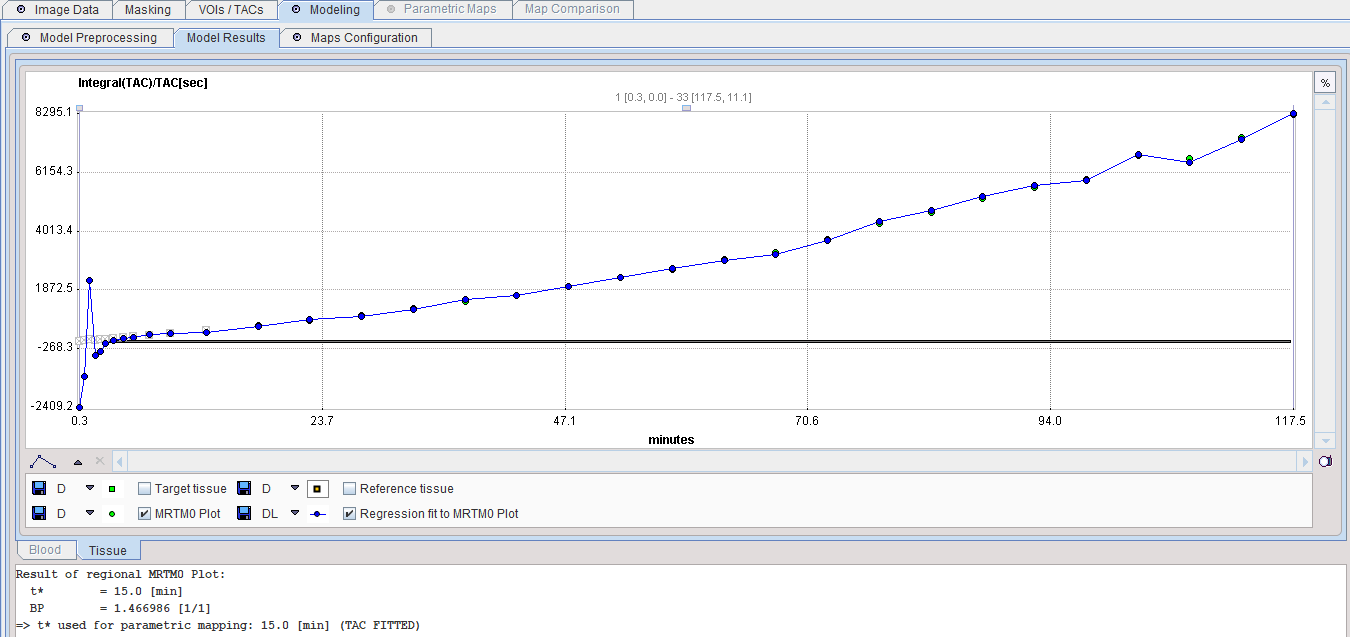Starting from the operational equation of the blood-based Logan plot, Ichise et al. derived three multi-linear reference tissue model variants MRTM0, MRTM and MRTM2 [1,2]. They all assume an initial equilibration time t* from which on the derived multi-linear relation holds. However, if kinetics in the target tissue can be described by a 1-tissue compartment model (an assumption required for the SRTM), all data can be used for the fitting (t*=0). Otherwise an adequate t* value has to be determined.
Assuming the presence of receptor-devoid reference region TAC CT'(t), the target tissue TAC CT(t) is transformed and plotted as a function of the transformed reference TAC, as illustrated below. For the calculation of BPND it is assumed that the non-displaceable distribution volumes in the tissue and reference regions are identical.

The MRTM0 model curve is described by

where VT and VT' are the total distribution volumes of CT(t) and CT'(t), k'2 is the clearance rate constant from the reference region to plasma, and b is the intercept term, which becomes constant for T > t*. The multi-linear relationship above can be fitted using multi-linear regression, yielding three regression coefficients. From the first coefficient the binding potential can be calculated by
![]()
For radioligands with 1-tissue kinetics such as 11C DASB the multi-linear equation is correct from T = 0, i.e., t* = 0, and b is equal to (-1/k2 ), where k2 is the clearance rate constant from the tissue to plasma. Furthermore, R1 = K1/K'1, the relative radioligand delivery, can be calculated from the ratio of the second and third regression coefficients.
Acquisition and Data Requirements
Image Data |
A dynamic data set acquired long enough that the equilibrium relation is approximately fulfilled. |
Target tissue |
Optional: TAC from a receptor-rich region (such as basal ganglia for D2 receptors). Only used for visualization of model fitting. Note: specification of an appropriate reference TAC is crucial for the result! |
Reference tissue |
Mandatory: TAC from a receptor-devoid region (such as cerebellum or frontal cortex for D2 receptors). |
Model Preprocessing

t* |
The least squares estimation should be restricted to a range after an equilibration time. t* marks the beginning of the range used in the multi-linear regression analysis. It can be fitted based on the Max. Err. criterion. |
Max. Err. |
The maximal relative error allowed if t* is fitted. |
Percent masked pixels |
Exclude the specified percentage of pixels based on histogram analysis of integrated signal energy. Not applied in the presence of a defined mask. |
The result of a model fit during Model Preprocessing is shown in the Model Results panel for inspection. Note that the initial points which are not taken into account (before the t* time) are indicated in grey. If no Target tissue is specified, the panel remains empty.

Model Configuration

BPnd |
Binding potential, calculated by: BPnd = k3/k4 = Vt/Vt'-1.0. |
Vt/Vt' |
First multi-linear regression coefficient of the operational equation. |
Vt/(Vt'k2') |
Second multi-linear regression coefficient of the operational equation. |
b |
Intercept in the operational equation. |
References
1.MRTM0: Ichise M, Ballinger JR, Golan H, Vines D, Luong A, Tsai S, Kung HF: Noninvasive quantification of dopamine D2 receptors with iodine-123-IBF SPECT. J Nucl Med 1996, 37(3):513-520.
2.Comparison of the MRTM and SRTM models: Ichise M, Liow JS, Lu JQ, Takano A, Model K, Toyama H, Suhara T, Suzuki K, Innis RB, Carson RE: Linearized reference tissue parametric imaging methods: application to [11C]DASB positron emission tomography studies of the serotonin transporter in human brain. J Cereb Blood Flow Metab 2003, 23(9):1096-1112. DOI